 |
|
|
| (Information by Peter Kessler, with additional information from Eden, Bit Adini, and Beth Eden, Alan Millard, from Europe Before History, Kristian Kristiansen, from An Introduction to Old Persian, Prods Oktor Skjaervo (Harvard 2002), from The Routledge Handbook of the Peoples and Places of Ancient Western Asia, Trevor Bryce, from The Ancient Near East, c.3000-330 BC, Amélie Kuhrt (Volumes I & II, Routledge, 2000), from The Armenians, A E Redgate (Basil Blackwell, 1998, 2000), and from External Link: Metropolitan Museum of Art in New York, USA.) |
|
|
| 1200s BC |
The first references to a political organisation in this region comes when the [ Assyrians](MesopotamiaAssyria.htm#Assyrian Empire) campaign to the north of Syria and encounter what they call the Nairi and Uruatri. These separate political entities eventually join forces, probably in the face of such Assyrian aggression. This new state's emergence is one of many such cases following the collapse of the Hittite empire in eastern Anatolia. |
|
| 1000s BC |
Between the eleventh and seventh centuries the [Assyrians](MesopotamiaAssyria.htm#Assyrian Empire) refer to the Urartuans as their northern enemies. During this time, the Urartuans adapt Assyrian cuneiform writing to create a 'dialect' of their own, and their later rock inscriptions use this writing to express the Urartuan language. 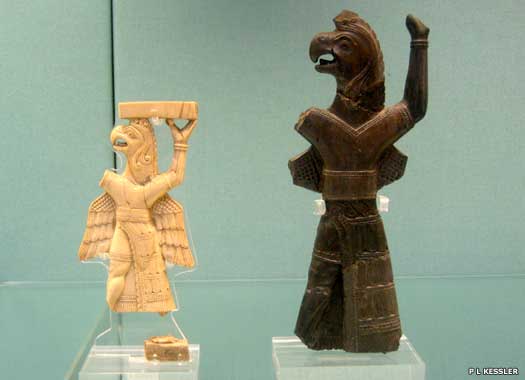 Urartuan ivories were a prized luxury, and the two griffin-headed demons of white and black ivory pictured here were perhaps made to decorate a throne Urartuan ivories were a prized luxury, and the two griffin-headed demons of white and black ivory pictured here were perhaps made to decorate a throne |
|
| c.860 - 844 BC |
Aramu / Arame |
Earliest-known and perhaps first king of Urartu. |
| 856 BC |
Following his conquest of Bit-Adini, the Assyrian forces of Shalmaneser III enter Urartu from the west and traverse its length. The campaign climaxes with a battle at the Urartuan capital of Arzashkun, which is destroyed. There follows a period of obscurity in Urartu during which the little-known Lutipri rules. |
|
| c.844 - 834 BC |
Lutipri |
Not on all lists. |
| c.834 - 825 BC |
Sarduri I / Sarduris |
Son. 'King of the Four Quarters'. |
Sarduri unifies the state of Urartu, initiates its royal dynasty, and founds a new capital at Tushpa, as attested in the accounts of Shalmaneser III. The earliest known Urartuan written document, a rock inscription at Van (ancient Tushpa), records the earliest internal reference to the state (albeit in the Assyrian language, not Urartu's own language). It says that Urartu is ruled by Sarduri and mentions a male deity named Haldi, the supreme god throughout Urartuan history. Sarduri's immediate successors turn the state into an important power which, at its height incorporates the territory formed by modern Armenia. 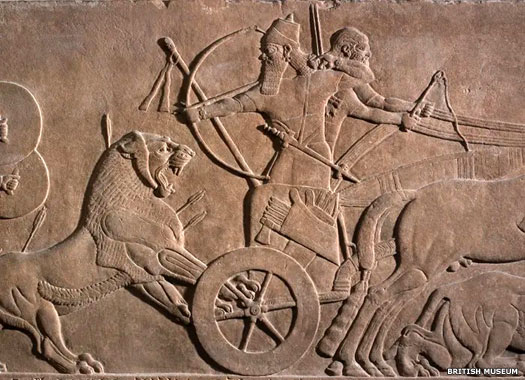 Ashurnasirpal II undertook the expansion and recovery of Assyria following general social collapse and a short dark page period between about 1200-900 BC Ashurnasirpal II undertook the expansion and recovery of Assyria following general social collapse and a short dark page period between about 1200-900 BC |
|
|
| Modern Yerevan is located where ancient Urartuan Erebuni is at this time, and the name remains virtually the same today after nearly three thousand years. Urartu also occupies the Zagros Mountains to the east of Assyria, and consolidates its territorial gains by building a series of mountain fortresses, such as Rusa-patari, 'Small city of King Rusa', or Teishebaini, 'City of the god Teisheba'. |
|
|
| 832 - 827 BC |
Shalmaneser III organises a series of five campaigns against Urartu in a concerted attempt by Assyria to halt its expansion. |
|
| c.825 - 810 BC |
Ishpuinis |
Son. 'King of the land of Nairi'. |
| Ishpuinis continues the work of expanding the kingdom. He conquers the Indo-European Mannaean city of Musasir, which subsequently becomes Urartu's religious centre. Then he is attacked by the Assyrian king, Shamshi-Adad V, defeating the invaders and confidently proclaiming himself to be the 'Glorious King'. |
|
|
| c.810 - 785 BC |
Menua |
Son. Co-ruler during his father's last days. |
Menua further expands the kingdom, building a large number of fortresses and leaving behind a great many rock inscriptions. He also develops the canal and irrigation which remains at least party used today. 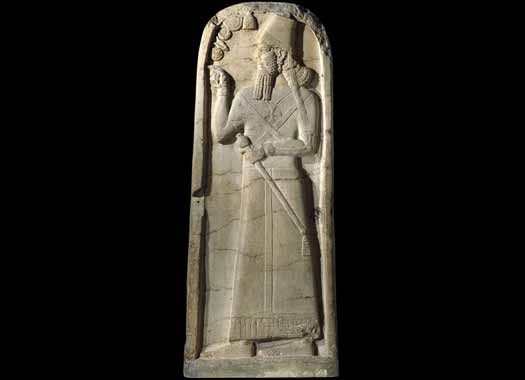 Shown here is a stela which has been dated to the reign of Shamshi-Adad V of Assyria and which was discovered at the site of Kalhu in the mid-nineteenth century AD Shown here is a stela which has been dated to the reign of Shamshi-Adad V of Assyria and which was discovered at the site of Kalhu in the mid-nineteenth century AD |
|
|
| c.785 - 763 BC |
Argishti I |
Son. |
| Argishti continues the series of conquests initiated by his predecessors. He is victorious against Assyria, conquers the northern part of [ Syria](SyriaCityStates.htm#Greater Syrian States), and makes Urartu the most powerful state in the post-Hittite Near East. The citadel of Erebuni (modern Yerevan in Armenia) is founded by him in 782 BC. Shamshi-ilu, the all-but independent Assyrian commander in northern Syria, does score a victory in battle against Uratu before 745 BC, as is recorded by a report on inscriptions of stone lions guarding the gateways at Kar-Shulmanu-Ashared. It makes no mention of his master, the Assyrian king. |
|
|
| c.763 - 734 BC |
Sarduri II |
Son. |
| 750 - 748 BC |
At the height of its power, Urartu is at war with [ Kolkis](../KingListsEurope/EasternGeorgia.htm#Kingdom of Kolkis) (which is situated on the south-eastern shore of the Black Sea, showing the extent of Urartuan expansion at this time). |
|
| 743 - 740 BC |
The Assyrians under Tiglath-Pileser III besiege [Bit Agusi](SyriaArpad.htm#Bit Agusi) for three years, thanks to the city being an ally of Urartu. Once captured, the city is destroyed and its inhabitants are massacred. It is probably around this period that the Urartuans also lose their domination of the northern part of [Syria](SyriaCityStates.htm#Greater Syrian States) (with the result that rulers of minor states there are forced back into Assyrian vassal status, such as Gamgum). Their defeat also opens up Anatolia to the Assyrians, and Tabal is almost instantly attacked. 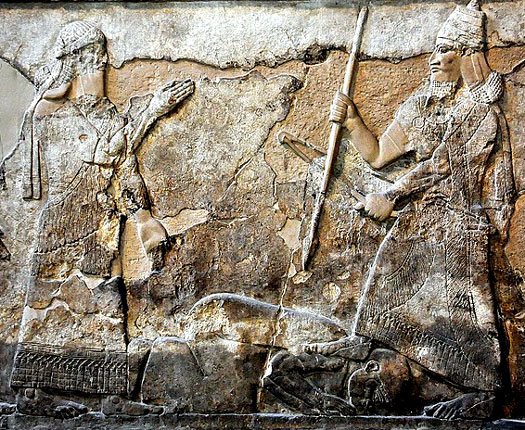 Tiglath-Pileser III dominated the Levantine city states during the later years of the eighth century BC, terminating the kingdom of Samaria and, shown here, with his foot on the shoulder of Hanunu of the Philistine city of Gaza, a gesture of dominance in the face of Hanunu's crouched submission Tiglath-Pileser III dominated the Levantine city states during the later years of the eighth century BC, terminating the kingdom of Samaria and, shown here, with his foot on the shoulder of Hanunu of the Philistine city of Gaza, a gesture of dominance in the face of Hanunu's crouched submission |
|
| c.740? - 737 BC |
Urartu is perhaps behind a major rebellion in northern [Syria](SyriaCityStates.htm#Greater Syrian States) against Assyrian vassals including Hamath and Sam'al. The Assyrian king is forced to campaign in the region to end the rebellion. |
|
| c.734 - 714 BC |
Rusa I |
Son. Fought against a resurgent Assyria. Committed suicide. |
| c.714 - 685 BC |
Argishti II |
Son. |
| 714 - 713 BC |
Much to the shock of Sargon of Assyria, while his main army is occupied in the east, Ambaris of Tabal allies himself with Midas of Phrygia and Rusa of Urartu (possibly immediately before the latter's suicide), as well as the local Tabalean rulers in an attempt to invade Que. Sargon reacts quickly, invading Tabal and capturing Ambaris, his family and the nobles of his country, all of whom are taken to Assyria. Tabal is annexed as an Assyrian province. Sargon is noted for using Cimmerians within his army on this campaign, possibly for their knowledge of the Urartuan hills as much as their ability as mounted warriors. Cimmerians have been raiding into Mesopotamia for decades. |
|
| 712 BC |
Two years after he sacks the cult centre of Musasir, Sargon II of Assyria sacks the neo-Hittite capital of Kummuhu. At the same time Cimmerians and Scythians invade Anatolia and the city declines. It is possible that Urartu also suffers from the same tribal incursions, and that the people responsible eventually destroy the kingdom as they pass through the region to control the central Zagros Mountains. 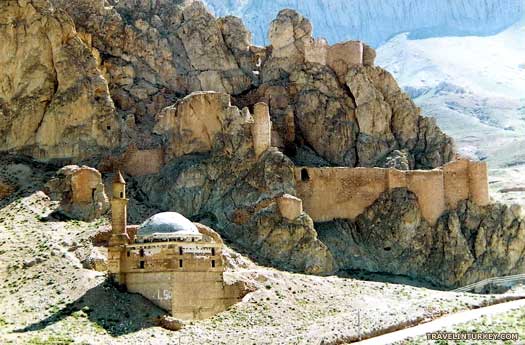 The Urartuan fortress built into the mountainous hills of Doğubeyazıt, close to Mount Ararat in modern Turkey The Urartuan fortress built into the mountainous hills of Doğubeyazıt, close to Mount Ararat in modern Turkey |
|
| c.685 - 645 BC |
Rusa II |
|
| 645 BC |
Following the death of Rusa II, details about Urartu become very obscure. In conjunction with Phrygia, it seems that Urartu may still support anti-Assyrian rebellions in northern [Syria](SyriaCityStates.htm#Greater Syrian States) and southern Anatolia. |
|
| c.645 - 635 BC |
Sarduri III |
|
| c.635 - 629 BC |
Erimena |
|
| c.629 - 615 BC |
Rusa III |
Son. May have remained king or over-king until 590 BC. |
| c.615 - 595 BC |
Sarduri IV |
Son. Possibly a co-ruler. Died without issue. |
| c.595 - 585 BC |
Rusa IV |
Brother. |
| 590/585 BC |
The territory which had formed the kingdom falls into the hands of theMedes, although the specific circumstances of Urartu's collapse are unknown. The end is violent, however, as its fortresses are burned down, apparently all close in time to one another, suggesting an organised campaign against Urartu which they are unable to resist. 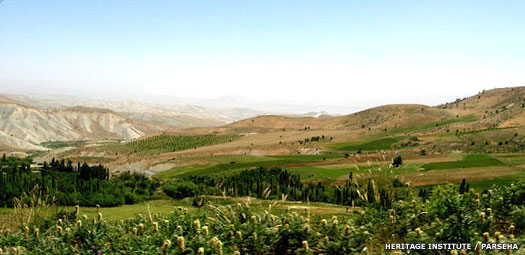 The Zagros Mountain range provided the Medes with their home, but it was also the Assyrian gateway into Iran, one that was used in later attacks on the Indo-European Persians and Medes The Zagros Mountain range provided the Medes with their home, but it was also the Assyrian gateway into Iran, one that was used in later attacks on the Indo-European Persians and Medes |
|
| The Urartuan language disappears, submerged beneath the various other languages used in the isolated mountain valleys, and the Armenian Indo-Europeans are next to emerge, their language apparently closely related to Phrygian and Cappadocian farther west. |
|
|
 |
|
|

 Urartuan ivories were a prized luxury, and the two griffin-headed demons of white and black ivory pictured here were perhaps made to decorate a throne
Urartuan ivories were a prized luxury, and the two griffin-headed demons of white and black ivory pictured here were perhaps made to decorate a throne Ashurnasirpal II undertook the expansion and recovery of Assyria following general social collapse and a short dark page period between about 1200-900 BC
Ashurnasirpal II undertook the expansion and recovery of Assyria following general social collapse and a short dark page period between about 1200-900 BC Shown here is a stela which has been dated to the reign of Shamshi-Adad V of Assyria and which was discovered at the site of Kalhu in the mid-nineteenth century AD
Shown here is a stela which has been dated to the reign of Shamshi-Adad V of Assyria and which was discovered at the site of Kalhu in the mid-nineteenth century AD Tiglath-Pileser III dominated the Levantine city states during the later years of the eighth century BC, terminating the kingdom of Samaria and, shown here, with his foot on the shoulder of Hanunu of the Philistine city of Gaza, a gesture of dominance in the face of Hanunu's crouched submission
Tiglath-Pileser III dominated the Levantine city states during the later years of the eighth century BC, terminating the kingdom of Samaria and, shown here, with his foot on the shoulder of Hanunu of the Philistine city of Gaza, a gesture of dominance in the face of Hanunu's crouched submission The Urartuan fortress built into the mountainous hills of Doğubeyazıt, close to Mount Ararat in modern Turkey
The Urartuan fortress built into the mountainous hills of Doğubeyazıt, close to Mount Ararat in modern Turkey The Zagros Mountain range provided the Medes with their home, but it was also the Assyrian gateway into Iran, one that was used in later attacks on the Indo-European Persians and Medes
The Zagros Mountain range provided the Medes with their home, but it was also the Assyrian gateway into Iran, one that was used in later attacks on the Indo-European Persians and Medes